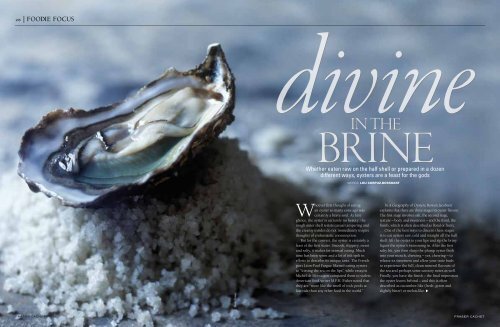Desert Jewels - Frasers Hospitality
Desert Jewels - Frasers Hospitality
Desert Jewels - Frasers Hospitality
Create successful ePaper yourself
Turn your PDF publications into a flip-book with our unique Google optimized e-Paper software.
28 | fOODiE fOCus<br />
fraser cachet<br />
Photo: Corbis<br />
Whether eaten raw on the half shell or prepared in a dozen<br />
different ways, oysters are a feast for the gods<br />
Whoever first thought of eating<br />
an oyster so many eons ago was<br />
certainly a brave soul. At first<br />
glance, the oyster is certainly no beauty: the<br />
rough outer shell resists casual tampering and<br />
the creamy insides do not immediately inspire<br />
thoughts of enthusiastic consumption.<br />
But for the convert, the oyster is certainly a<br />
feast of the first water. Smooth, slippery, sweet<br />
and salty, it makes for sensual eating. Much<br />
time has been spent and a lot of ink spilt in<br />
efforts to describe its unique taste. The French<br />
poet Léon-Paul Fargue likened eating oysters<br />
to “kissing the sea on the lips”, while essayist<br />
Michel de Montaigne compared them to violets.<br />
American food writer M.F.K. Fisher noted that<br />
they are “more like the smell of rock pools at<br />
low tide than any other food in the world.”<br />
WORDS: Lou corpuz-Bosshart<br />
In A Geography of Oysters, Rowan Jacobsen<br />
explains that there are three stages in oyster flavour.<br />
The first stage involves salt, the second stage,<br />
texture – body and sweetness – and the third, the<br />
finish, which is often described as floral or fruity.<br />
One of the best ways to discern these stages<br />
is to eat oysters raw, cold and straight off the half<br />
shell: lift the oyster to your lips and sip the briny<br />
liquor the oyster’s swimming in. After the first<br />
salty hit, you then slurp the plump oyster flesh<br />
into your mouth, chewing – yes, chewing – to<br />
release its sweetness and allow your taste buds<br />
to experience the full, clean mineral flavours of<br />
the sea and perhaps some savoury notes as well.<br />
Finally, you have the finish – the final impression<br />
the oyster leaves behind – and this is often<br />
described as cucumber-like (fresh, green and<br />
slightly bitter) or melon-like.<br />
fraser cachet




